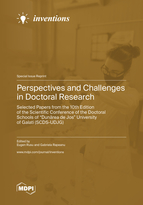Perspectives and Challenges in Doctoral Research—Selected Papers from the 10th Edition of the Scientific Conference of the Doctoral Schools of “Dunărea de Jos” University of Galati (SCDS-UDJG)
A special issue of Inventions (ISSN 2411-5134).
Deadline for manuscript submissions: closed (31 December 2022) | Viewed by 34755
Special Issue Editors
Interests: renewable energy; marine engineering; offshore technologies
Special Issues, Collections and Topics in MDPI journals
Interests: biologically active compound extraction and characterization; degradation and inactivation kinetics of biological active compounds; encapsulation techniques; food authentication
Special Issues, Collections and Topics in MDPI journals
Special Issue Information
Dear Colleagues,
We are inviting submissions to a Special Issue of the Invention journal for participation in the 10th edition of the Scientific Conference of the Doctoral Schools from “Dunărea de Jos” University of Galaţi. The objective of the 2022 Conference is to bring together perspectives and challenges in doctoral research to a common forum. The aim of the conference is to provide a platform to the doctoral researchers to meet and share state of the art developments in their field. On this occasion, our institution targets to promote excellence in research, to set up partnerships and collaborative relationships through the exchange of knowledge and expertise. As in the previous editions, the conference invites oral and poster presentations in sections related to the main domains of the doctoral research at UDJG. Workshops, exhibition stands, and social activities are also included in the programme, all with the aim of developing and improving the network of the doctoral schools.
All the papers presented in the conference and accepted for publication in this Special Issue will benefit of a 50% discount for the APC.
Prof. Dr. Eugen Rusu
Prof. Dr. Gabriela Rapeanu
Guest Editors
Manuscript Submission Information
Manuscripts should be submitted online at www.mdpi.com by registering and logging in to this website. Once you are registered, click here to go to the submission form. Manuscripts can be submitted until the deadline. All submissions that pass pre-check are peer-reviewed. Accepted papers will be published continuously in the journal (as soon as accepted) and will be listed together on the special issue website. Research articles, review articles as well as short communications are invited. For planned papers, a title and short abstract (about 100 words) can be sent to the Editorial Office for announcement on this website.
Submitted manuscripts should not have been published previously, nor be under consideration for publication elsewhere (except conference proceedings papers). All manuscripts are thoroughly refereed through a single-blind peer-review process. A guide for authors and other relevant information for submission of manuscripts is available on the Instructions for Authors page. Inventions is an international peer-reviewed open access semimonthly journal published by MDPI.
Please visit the Instructions for Authors page before submitting a manuscript. The Article Processing Charge (APC) for publication in this open access journal is 1800 CHF (Swiss Francs). Submitted papers should be well formatted and use good English. Authors may use MDPI's English editing service prior to publication or during author revisions.
Keywords
- advanced research in mechanical and industrial engineering
- progress in food science and bio-resources engineering
- advances in engineering and management in agriculture and rural development
- advanced research in electrical/electronic engineering, system engineering and information technologies
- future of eco-nanotechnologies, functional materials and coatings
- chemistry
- electrochemistry in life sciences







